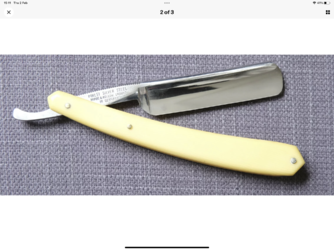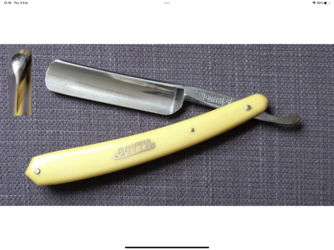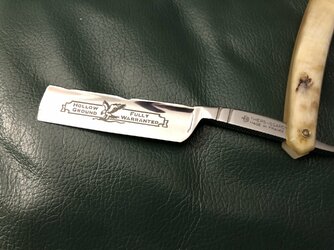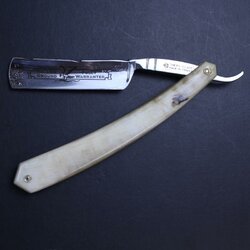Just had shave number 6 and it was a real disappointment. Razor really felt like it was dragging on my chin. Almost to the point where I felt it could possibly be dangerous. Left my chin really irritated so I abandoned and cleaned up with a DE.
I have ordered a vintage shave ready razor today off eBay and so I will see how sharp that is in comparison. I ordered it off a vendor that restores razors and offers a honing service so he is well 2.4k items sold and 100% feedback so I should be in good hands.
I’m hoping that this razor will be a world apart from the new TI I purchased which was apparently sent out shave ready. Attached is both my new TI and the vintage razor on order.
I‘ve no reason to doubt that my TI wasn’t shave ready when I got it as I seem to remember the first time thinking how sharp it seemed. Maybe my stropping technique is causing the issue.
so my thoughts are to wait for the vintage razor to arrive and hope it feels much sharper. If it does I shall then try and bring the blunter TI back to life with chromium oxide on a cotton strop then leather. If I fail at that then I shall send the TI out to the person I bought the vintage razor off for sharpening.
In the meantime I shall try and keep on top of the vintage razor with stropping only, then when I’m not happy take it to the chromium oxide. it’s hard to judge if my stropping is causing any issues. I may take it to the local Turkish barber I use and ask him if he is good with a strop. He said he learnt to shave with a cut throat age 13 when he didn’t even need to shave as his dad was a barber. Don’t know if he will still have the skill though as in the UK you can only use shavettes in barbers shops.
Any ideas what route I should go down or am I thinking correctly?
I have ordered a vintage shave ready razor today off eBay and so I will see how sharp that is in comparison. I ordered it off a vendor that restores razors and offers a honing service so he is well 2.4k items sold and 100% feedback so I should be in good hands.
I’m hoping that this razor will be a world apart from the new TI I purchased which was apparently sent out shave ready. Attached is both my new TI and the vintage razor on order.
I‘ve no reason to doubt that my TI wasn’t shave ready when I got it as I seem to remember the first time thinking how sharp it seemed. Maybe my stropping technique is causing the issue.
so my thoughts are to wait for the vintage razor to arrive and hope it feels much sharper. If it does I shall then try and bring the blunter TI back to life with chromium oxide on a cotton strop then leather. If I fail at that then I shall send the TI out to the person I bought the vintage razor off for sharpening.
In the meantime I shall try and keep on top of the vintage razor with stropping only, then when I’m not happy take it to the chromium oxide. it’s hard to judge if my stropping is causing any issues. I may take it to the local Turkish barber I use and ask him if he is good with a strop. He said he learnt to shave with a cut throat age 13 when he didn’t even need to shave as his dad was a barber. Don’t know if he will still have the skill though as in the UK you can only use shavettes in barbers shops.
Any ideas what route I should go down or am I thinking correctly?






